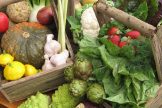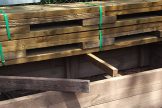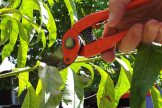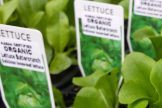
There is nothing like the taste and satisfaction of growing your own vegies. Not only are there the health benefits of growing your own produce for your family, you are also helping the planet by reducing your food miles. Kids love planting vegies and watching them grow, so it’s a great outdoor activity for the whole family. If you have never tried or would like a bit of a refresher this is a great place to start.
Where to Plant?
Give your vegie patch the sunniest spot in the garden with a minimum of five hours direct sunlight a day. Good drainage is preferable but you can always build up a garden on top of your soil or plant in pots.
Pick somewhere near the back or front door so you can easily harvest your vegetables and monitor it as you walk by daily. Dig up lawn area or tired ornamental beds if you have to get the ideal spot.
How Big an Area?
Organic Gardening expert Jackie French says to work out whatever lawn area you actually need, then plant up the rest! If you aren’t ready to go to that extreme, which is probably good if you’re just starting out, it’s best to start in a nice manageable size like 2-3m2. You can expand your vegie patch as your skills expand and you get more and more addicted to your fresh, home grown food.
How to set it up?
In a traditionally prepared vegie patch, you need to dig and turn over the soil, breaking up the ‘clods’ of earth into what’s called a fine tilth, or until it’s crumbly.
All vegie patches need a rich soil, so no matter what sort of soil you have, add some mushroom compost or cow manure and sprinkle round some potash, then dig it in.
Otherwise you can make a ‘No Dig’ Vegie Garden by creating an edge and filling in with manure and compost, mulch and newspaper. This method is a lot less hard work!
Mulch
Mulch keeps the weeds down and the moisture in, and makes a huge difference! Mulch the soil before you plant then scrape the mulch aside for each seedling. This will save you time. Keep the mulch a little away from the new plants so they don’t rot. The best mulch to use for a vegie patch is pea straw or lucerne.

What to plant?
Plant something easy to grow and, more importantly, what you like to eat. Pick from our list of top 10 easy grow herbs and vegetables below, or you can refer to the lists in each month’s ‘In Your Garden’ page. (the current month is always on the front of our website)
Top 10 easy grow herbs
Parsley, Sage, Rosemary, Thyme, Oregano, Bay, Chives, Garlic Chives, Coriander (in cool weather), Basil (in warm weather)
Top 10 easy grow vegies
Lettuce, Spring Onion, Cherry Tomatoes, Chillies, Zucchini, Beans (in warm weather), Rocket, Snow Peas, Bok Choy, Mustard Greens(in cool weather)

Help nature to control pests in your garden by also planting some beneficial insect attracting flowers like Alyssum, Foxglove, Phacelia, Echinacea, Bergamot, Poppies and Calendula. Include some Coriander and Dill which you can let go to seed and self-propagate in the garden. For more info, please see our Companion Planting Factsheet.
Planting
Sow seeds according to the depth and spacing advice on the packet. Seedling tags and our ‘shelftalkers’ (the little signs located in front of the seedlings in the nursery) tell you how far apart to plant your seedlings. Plant seedlings to the same depth as they were in the punnet and always plant into moist soil. Water your seedlings in with a seaweed fertiliser, encouraging new root growth and disease resistance.
Watering
Herbs and vegies grow very fast, so they need a good supply of water. More when it’s hot and windy and less when it’s cool. A good rule of thumb for a mulched garden with rich soil is every 1-2 days in the spring / summer and every 2-5 days in the autumn / winter. Add lots of ‘organic matter’ (composts and manures) to the soil. Organic soils grow the best produce with up to 75% less water than in non-organic soils.
When to Plant?
Plant at the right time for the best results! There are two ideal times of year for most herbs and veg. The first is spring, with planting beginning after the last frost, which is usually around late September. Autumn is the other main planting time, as soon as the sting goes out of summer, which is usually around mid-March. Each month in our ‘In Your Garden’ factsheet you will find a list of herbs, vegies and companion plants that can be planted from seeds and seedlings at that time of year. You will find the current month’s ‘In Your Garden’ on the front page of the website. Click here for our easy-to-use monthly planting guide!

It is important consider the type or style of garden you want before construction of begins in earnest. Examples of styles may include:
-
The Kitchen Garden, a traditional walled or courtyard garden;
-
The Potager Garden, a romantic, decorative garden;
-
A Permaculture garden, providing organic fruit and veg for you and your family.
Factors that will have a bearing on the long-term success of your garden will include:
-
The amount of time available to devote to its upkeep and maintenance;
-
The amount of useable space at your disposal;
-
The suitability of the available space
Most garden vegetables are planted on an annual basis (either for cool or warm season growth) however, several plants including rhubarb, globe artichokes, strawberries and asparagus survive for many seasons, and along with fruit trees should be considered as permanent plantings. These considerations may also influence the style layout and design of a produce garden.
Traditional culinary herbs can also add colour and fragrance to a produce garden. Their uses include flavouring or garnishes for cooking, as infusions in drinks, as insect and pest repellents, as companion plants or for medicinal remedies. Also remember Oriental and Asian herbs and vegetables as authentic oriental cooking is now much in vogue and the demand for these oriental vegetables and herbs has increased. Generally speaking oriental greens enjoy the cold but may bolt in the heat. They are quick growers and high in Vitamin C. Take particular care with Vietnamese Mint that is very invasive if it escapes into the natural environment.

What you need for a healthy and productive Herb, Fruit or Vegie Garden
Soil
The soil forms the basis of the produce garden. It provides oxygen, water and nutrients to the plant roots,
necessary for their growth. A productive soil should have good structure, be well drained, and be rich in compost and manure, known as humus.
The addition of organic manures and compost is fundamental to the success of vegetable gardens. Organic matter provides nutrients for plants as it is broken down by soil micro-organisms eventually forming part of the humus layer in the soil. This greatly improves soil structure leading to better drainage, oxygen availability, water retention and nutrient holding capacity.
A well composted soil is ideal for growing healthy vegetables. It will encourage a large worm population, supply ample nutrients, good soil structure and drainage. Composting is also excellent as it recycles all green waste from the kitchen.
Sun
It is important that fruit and vegetables receive sufficient sunlight for their growth requirements. Vegetables grow quickly and need sunlight for photosynthesis to produce the energy needed for this growth. Northern aspects are ideal for a produce garden with beds running roughly in a north – south direction. At least 4 to 5 hours exposure to sunlight a day is recommended for most fruit and vegetables.
Water
Regular watering is also essential for successful fruit and vegetable crops. Water is a precious resource and it may be worth considering the installation of a rainwater tank or a grey water system which re-uses laundry water.
Rainwater may be limited by the season (i.e. summer) but grey water is available every time the washing machine is used! Water flow can be regulated to the garden by the use of soaker hoses or the installation of irrigation systems.
Mulch
Mulches play an important role in the Herb, Fruit & Vegie garden. A layer of Pea Straw or Lucerne Hay mulch will retain soil moisture, protect plant roots from summer heat, return organic matter to the soil, keep fruits off the soil surface and reduce the incidence of weed competition.
Maintenance And Care
Planting times will vary for different vegetables, herbs or fruits depending on their growing seasons. Generally speaking warm season vegetables are planted out in spring and cool season vegetables planted in autumn. Fruit trees, vines and shrubs, and some root crops are planted in winter. It is essential to plan ahead and ensure space is available throughout the year for different annual vegetables.
The presence of weeds in produce gardens is undesirable. Weeds compete for valuable resources and may attract or harbour pests and diseases. Proper mulching of the garden will significantly reduce the weed load after which gardeners must be prepared to spend some time removing those that continue to grow.
Pests and diseases are a natural part of the plant kingdom and it is not possible or desirable to totally eliminate them. Gardeners should aim to achieve a balance of pests and predators, in which pest numbers do not jeopardise crops, but still provide a food source for the predators such as birds, spiders and predatory insects. Healthy soils and sensible planting and watering also help reduce the incidence of pest and disease.
It is important to remember if chemical sprays are still required to control pests, many insects are beneficial, and most sprays will kill indiscriminately. Therefore, it is wise to use these produces with care. Only use sprays that are appropriate to the problem and if unsure ask for advice. Always use the least toxic spray to control the problem.
This is to protect both you and your family, as you are eating the produce you have sprayed. Read all information carefully provided on the packaging of the chemical you are using, especially the withholding period. Never store any chemicals or sprays, (even home made brews), in food containers, without a clear label and date, in the fridge or kitchen cupboard.
Crop rotation helps to maintain a healthy soil profile and minimises the transfer of disease from one crop to another. In general, root crops follow legumes and leaf crops, which are followed by the cucurbits, capsicums, eggplant and tomato. It is a good idea to periodically leave some areas fallow (nothing planted) or plant a green manure crop that is dug into the soil.
Fruit trees, shrubs and vines will need periodic pruning. Most fruit trees will require summer and winter pruning to produce a good crop of fruit each year. The structural pruning is carried out in winter. This forms the framework of the tree. In summer, water shoots and upright branches are trained down horizontally, to encourage fruiting over stem growth. It is also necessary to check if each crop needs thinning. This is best done at the flowering stage.
Regular harvesting of vegetables, herbs and fruit, allows you to check the health of the plants as they grow and contributes to crop hygiene. Do not leave old fruit, vegetables and pruning material underneath the plants as these can harbour disease. Compost this material, unless the plant has a disease.
Troubleshooting
If you have a lot of clay, add some gypsum as well as compost. If you are digging into heavy clay in less than a shovels depth, then make a ‘No Dig’ bed.
When pests and disease visit, don’t worry! Caught early, most problems are very simple to deal with. You are not alone!
Look for nearby signage to guide you when you purchase your plants and ask our staff about any common problems to expect before you go home. Observe your patch every day, if you notice something going wrong bring us in an infected piece to diagnose for you.
Armed with this know how, go forth and enjoy your home grown bounty!





